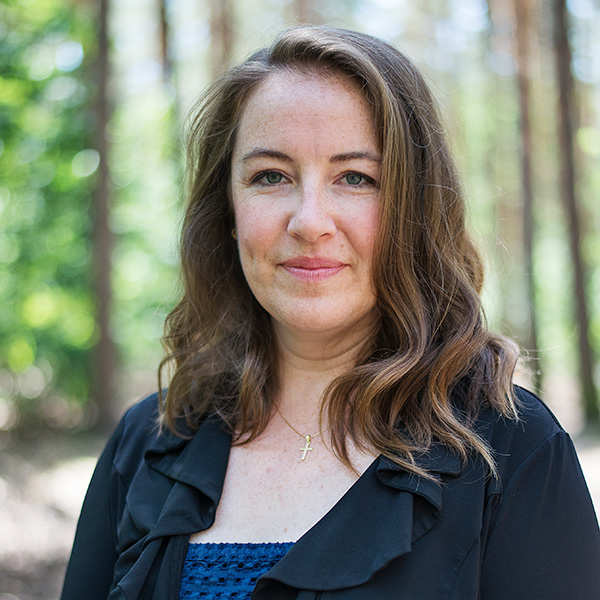The labyrinth was covered in autumnal flotsam after a recent storm. No one was walking its path that day.
We weren’t much of a labyrinth-walking bunch, those of us on this church retreat. The afternoon free time options included Ultimate Frisbee for the youth, gluing projects for the littlest, and a nearby lavender farm and winery for the adults.
I have rarely been instinctively drawn to labyrinths. But when I saw this one on a map of the retreat grounds, I decided to give it a look during our break. That’s how I put it when friends asked me what I was going to do: “I’m going to give the labyrinth a look.” Just looking — no plans to buy.
But in truth, I wasn’t just looking. I needed the labyrinth to do something for me, although I was afraid to face precisely what. Since it was strewn with leaves, branches and even a few felled limbs, I figured I could clear it as I walked, though I also wondered whether that would inhibit it from working.
My inner cynic began to heckle: “How does one make a labyrinth work, anyway?”
As I cleared leaves from one part of the path, they piled up into another. Given the analogies of labyrinths to the mysteries of human life, it felt painfully on the nose, practically honking it.
“You might as well be kicking cans down a road,” the cynic’s mocking continued.
The symbols were decaying into self-help satire faster than I could meaningfully take them in, which heightened my sense of isolation. Why was I doing this exercise in faux contemplation instead of sipping lavender wine with all the other “normal” adults? I grabbed a pine branch to try to improve my clearing efforts, but my improvised broom didn’t help.
Finally, I decided that enough was enough. I was determined to wrench some meaning from the clenched jaws of that meandering circle by free time’s end. Going back to the labyrinth’s beginning, hearing the happy voices of Frisbee players from the soccer field nearby, I set upon the path in an ironclad meditative grip.
Twist, turn, straightaway.
Just when I thought I was about to puncture its central yoke of meaning, the path diverged, tacking away. Although I knew the symbolism intellectually, the embodied subtlety of it still took me by surprise. The path managed to stay ever beyond the reach of my mind’s lurching, almost algorithmic attempts to anticipate it. Sooner than I expected, I came to the labyrinth’s end.
But I was still knotted up. The labyrinth had not worked. No angels descended; no flaming swords appeared.
Feeling suckered, I left to try to wrench something else from free time. It was only then that I realized my mind’s eye was beholding an image of a woman with a broom, a character in one of Jesus’ parables. Having discovered that one of her 10 pieces of silver was missing, she lit a lamp and swept until she found it. When she did, she invited her neighbors over to celebrate with her.
The labyrinth had appealed to me for a reason. I was standing at the throat of a forking path, fearful of a decision at a moment of complex vocational discernment. How long had I been in a kind of dark woods, kicking at and sweeping at leaves alone, hoping for something magical to happen? The labyrinth refused to cooperate with what I demanded of it, a refusal that propelled me to keep sweeping and searching, admitting that I needed more than ironclad determination, that I needed to invite others into the grip of my loneliness.
A few weekends after my failed labyrinth experiment, I convened a “clearness committee,” using Parker Palmer’s rubric. A Quaker method of discernment, a clearness committee is designed to help a person gather wisdom toward a decision of some kind.
Like a labyrinth, it has a form. There are clear rules and a moderator who keeps the time and umpires the conversation. Committee members must be capable of deep, patient listening, willing to relinquish their own need to control and to refuse inquirers a quick fix. They lift their own lamps of inquiry to offer new angles of light into dark corners, but only to help conveners see better for themselves, to reach into their own corners with their brooms.
Indeed, the afternoon gathering was planned to shine a bright, attentive light upon my life and its inner pain. After going over the rubric and the rules, I had 15 minutes to tell the committee my problem. I named out loud to them fears and doubts that I had long avoided admitting, even to myself.
The committee members were given an hour and a half to ask me free-ranging, open-ended questions — that is, importantly, questions to which they themselves did not know the answer. This particular formulation guarded against the usual human compulsion to give advice cloaked in the guise of a question.
Some of their questions pierced me like swords, yet I found that they did not wound me. I was allowed to answer, which generated new questions. We sat in a time of silence, after which the committee members, each in turn, told me what they had heard and observed from me. Only then were they permitted, if they wanted, to tell me what they thought I should decide. Very few opted to do so.
The hours of the meeting passed in a brisk moment of deeply shared flow. To be held in such sustained attention like that for so long, in that kind of vulnerable, truthful exchange, was transcendent for all of us, not just for me. Neither painless nor painful, it was both labored and surprisingly energizing. My scornful inner cynic vanished in that light. Though I remained in a labyrinth of discerning, I saw that I was utterly companioned in it.
Indeed, in ways that the labyrinth could not, given how I was treading it, the clearness committee helped me become far more aware of the reality of others. We all felt that balm. Somehow, we all felt freer at the meeting’s end, reoxygenated, recalibrated, swept up and swept out, even though the labyrinth of each of our lives remained mysterious.
Neither the clearness committee nor the labyrinth worked, but paradoxically, they both helped me refuse to quit the questions. I have endured a little longer on the same winding, twisting path, and I can better see others walking near me on their own leaf-strewn labyrinths too. Thankfully, there are still people in this world capable of showing up with lamps and brooms, ready to join the party to celebrate what is found.
Although I knew the symbolism intellectually, the embodied subtlety of it still took me by surprise.














